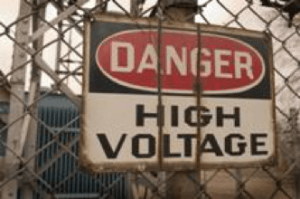CLIENT LOGIN
×Electrocutions & Burns
Electrocutions & Burns
Electricity is dangerous. More than 1000 people are killed each year because of electrocution, and more than 3000 are injured. Electrocution, sometimes referred to as electrical shock is a serious hazard. Electricity can cause severe injury and disruption to the tissue of the body, including severe burns and damage to the internal organs such as the nerves and heart. If you or a loved one has suffered a serve injury or death you need a firm with experience in your type of case. Gump, Faiella & Bugalski, has extensive experience in injury cases and has handled electrocution and arc flash cases.

Electrocution
Electrocution occurs from direct contact with electrical energy often by touching an exposed wire or line, or a conductor that has become energized with power. The higher the current the greater the severity of the shock. The energy from the source flows through the point of contact and through the body causing a shock. There may also be an exit point when the energy flows out of the body causing further injury. The amount of damage depends on the energy involved, and the environment.
Types of Injuries Caused by Electrocution
The most common injuries from electrocution are burns but a number of injuries can occur. For example, currents of 100 mil Amps up to 2 Amps may cause ventricular fibrillation, which is one of the most common causes of death from electrical shock. Electric shock can occur at energy levels that are present in common household circuits (110/120 volts), but can also occur at lower, or higher energy systems. Environments that are wet increase the risk of electric shock by lowering the resistance of human skin.
Electrocution injuries can include burns (1st° to the 4th°), brain injury, cardiac arrest, internal injuries to organs, muscles and soft tissue, and death. Because of the severity of these types of injuries a person may also suffered disfigurement, amputation, cognitive loss, memory loss, behavioral changes, seizures, and permitted loss of function. Victims of severe burns or amputation may also have anxiety, depression and social difficulties. It may be difficult or impossible to return to work, and full recovery, if possible, is a very long road.
Were You Harmed?
If you or a loved one suffered serious injury or death as a result of an electrocution or arc flash, you may be entitled to significant compensation for the injuries, if it was caused by the negligence of a:
- Power company,
- Electrical company,
- Property owner, or
- Defective product.
Who may be liable often depends if the injury occurred at work or not. Injuries occurring at work will typically involve a worker’s compensation claim but others may also be liable.
Injury at Work
Many electrocution cases occur on the job, although electrocutions can happen in many environments, including at home, or at play. A number of electrocutions happen to construction workers and electricians involved in the industry who may have claims against their employers, co-workers, or product manufacturers, if those people’s actions caused or contributed to their injuries. According to ELCOSH (Electronic Library of Construction Occupational Safety and Health), electrocutions are the fourth leading cause of death in construction workers, with an average of 143 construction workers dying each year from preventable electrical accidents.
Common Causes of Non-Work Electrocutions
Common electrical injuries include accidental contact with exposed electrical sources, accidental contact with power lines, either suspended by poles or underground power lines, improper wiring or grounding techniques, improper maintenance of existing electrical systems, damage to electrical systems due to infiltration of water or flooding, accidental contact between a conducting substance and an electrical source, electrical arc flashes, and improper warnings.
Unfortunately, people have been killed or injured by electric current where they would never expect the risk such as pools, spas, ponds and lakes. People are also injured from improperly wired or defect appliances or household products such as toasters, microwaves, dishwashers and electric blankets.
Any person who is involved in an electrical shock or arc injury who has suffered serious personal injury or loss of a loved one should act now to protect their legal rights. You may be entitled to compensation for past and future medical bills, lost wages, and pain and suffering.
Who Might be Liable for Electrical Injuries
Each case must be completely investigated because who may be liable depends on the specific facts and circumstances of each specific case. However, our experience has shown that the following parties may be liable parties:
- Power Companies,
- Construction companies and employees,
- Engineering Companies and employees,
- Electricians,
- Contractors or subcontractors,
- Manufactures, designers, and distributors of defective equipment,
- Property owners or lessors,
- Governmental entities such as counties, cities or other municipalities.
Cases Involving Power Companies
Power companies are providing a service to consumers will and have a duty to take care not to harm the customers to which they are providing service, as well as to the public which may foreseeably encounter or be harmed by their business activities in providing electrical power. So, power companies must keep the public safe from the electricity that they distribute as part of their business. Power companies are generally required to use the highest degree of care because of the extreme risk posed by high-voltage electricity.
Common Failures of Power Companies Causing Injury
- Failure to comply with the requirements of the national electric safety code (NESC).
- Failure to inspect, maintain or replace damaged equipment.
- Failure to respond to customer complaints of hazards like flooded lines, fallen power lines, tree limbs touching power lines, and damaged poles.
- Failure to properly hire, and train their employees
- Failure to follow industry standards.
Get an Attorney on Your Side
Electrocution cases are often extremely complex requiring a complete investigation of the cause and any defective equipment. It is important to pursue an investigation as soon as possible, to secure all the necessary evidence so it is possible to reconstruct what happened to determine if the cause of the incident can be attributed to a defective product, or the negligence of those charged with making the system safe.
If you or a loved one was injured by an electric shock hazard you may be entitled to compensation. To discuss your rights, contact the attorneys at Gump, Faiella & Bugalski now at 1-800-264-3455 or fill out a no risk contact form for a free consultation and evaluation of your claims. Our lawyers have handled electrocution and arc flash cases and can advise you of your legal rights and whether you may have a case for compensation.
Electrical Work Place Safety
Electrical injury in the works place is a serious concern. NFPA70E, Standard for Electrical Safety in the Workplace addresses arc flash and shock hazards. NFPA 70E includes tables for arc flash hazard identification and arc flash personal protective equipment (PPE) for various types and ratings of electrical equipment. As an employee you should be made aware of the hazards and receive proper protective equipment equal to the danger of the work environment. Your employer should know, teach and train you on the rules of safety and supply you with the proper equipment to do the job and stay safe. Other people on the jobsite or involved in the project may also owe you a duty of care to keep you safe from injury.
Basics of Electrical Safety
In general, to ensure that people are safe the responsible parties should adopt a safety program that address the risk of ethical shock. This includes elimination of the risk, by implementing system to ensure that power system is deenergized when work is taking place. Parts used are new and adequate for the system in use and environment in which they will be used. Barriers should be used to prevent access to systems by people who should not encounter them, and clear warning signs should be posted expressing the danger, risk and bad outcome if the warning is no followed. Lockout/Tagout programs should be implemented and followed so that power systems being worked on stay deenergized until the work is complete and it is safe to reenergize. Workers should be given appropriate PPE and have the necessary experience to work on the system.
If you or a loved one was injured or killed by an electric event you may be entitled to compensation. To discuss your rights, and legal options contact the attorneys at Gump, Faiella & Bugalski now at 1-800-263455 or fill out a no risk contact form for a free consultation and evaluation of your claims. Our lawyers have handled electrocution and arc flash cases and can advise you of your legal rights and whether you may have a case for compensation.
Powered by



